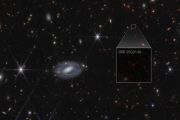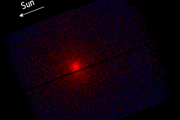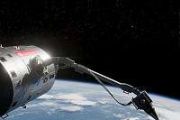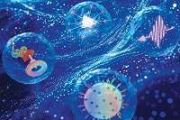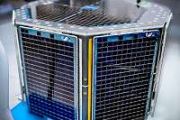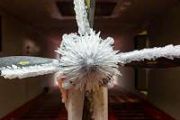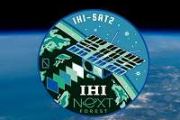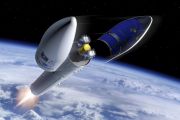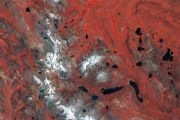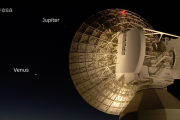
Copernical Team
From "i" for "inspiral" to "g" for "gamma-ray burst"
 Using supercomputer calculations, scientists at the Max Planck Institute for Gravitational Physics in Potsdam and from Japan show a consistent picture for the first time: They modeled the complete process of the collision of a black hole with a neutron star. In their studies, they calculated the process from the final orbits through the merger to the post-merger phase, in which according to thei
Using supercomputer calculations, scientists at the Max Planck Institute for Gravitational Physics in Potsdam and from Japan show a consistent picture for the first time: They modeled the complete process of the collision of a black hole with a neutron star. In their studies, they calculated the process from the final orbits through the merger to the post-merger phase, in which according to thei Astronomers detect a radio "heartbeat" billions of light-years from Earth
 Astronomers at McGill University, MIT and elsewhere have detected a strange and persistent radio signal from a far-off galaxy, that appears to be flashing with surprising regularity. Classified as a fast radio burst, or FRB, this new signal persists for up to three seconds, about 1,000 times longer than the average FRB. Within this window, the team detected bursts of radio waves that repeat ever
Astronomers at McGill University, MIT and elsewhere have detected a strange and persistent radio signal from a far-off galaxy, that appears to be flashing with surprising regularity. Classified as a fast radio burst, or FRB, this new signal persists for up to three seconds, about 1,000 times longer than the average FRB. Within this window, the team detected bursts of radio waves that repeat ever An ocean of galaxies awaits
 Sometime around 400 million years after the birth of our universe, the first stars began to form. The universe's so-called dark ages came to an end and a new light-filled era began. More and more galaxies began to take shape and served as factories for churning out new stars, a process that reached a peak about 4 billion years after the Big Bang.
Luckily for astronomers, this bygone era ca
Sometime around 400 million years after the birth of our universe, the first stars began to form. The universe's so-called dark ages came to an end and a new light-filled era began. More and more galaxies began to take shape and served as factories for churning out new stars, a process that reached a peak about 4 billion years after the Big Bang.
Luckily for astronomers, this bygone era ca Moving Right Along - Sol 3531
 Since we finished up with our "Avanavero" drill activities yesterday, we're officially back on the Martian road to the layered sulfate-bearing unit! Today we just planned a single sol's worth of activities, and filled the day with contact science, remote sensing, and a 50m+ drive.
The remote sensing and contact science activities include a MAHLI and ChemCam LIBS observation of a bedrock ta
Since we finished up with our "Avanavero" drill activities yesterday, we're officially back on the Martian road to the layered sulfate-bearing unit! Today we just planned a single sol's worth of activities, and filled the day with contact science, remote sensing, and a 50m+ drive.
The remote sensing and contact science activities include a MAHLI and ChemCam LIBS observation of a bedrock ta NASA Highlights Climate Research on Cargo Launch, Sets Coverage
 NASA and SpaceX are targeting 8:44 p.m. EDT Thursday, July 14, to launch the agency's next investigation to monitor climate change to the International Space Station. The mission, NASA's Earth Surface Mineral Dust Source Investigation (EMIT), will fly aboard SpaceX's 25th commercial resupply services mission to the orbital laboratory.
SpaceX's Dragon spacecraft will lift off from Launch Co
NASA and SpaceX are targeting 8:44 p.m. EDT Thursday, July 14, to launch the agency's next investigation to monitor climate change to the International Space Station. The mission, NASA's Earth Surface Mineral Dust Source Investigation (EMIT), will fly aboard SpaceX's 25th commercial resupply services mission to the orbital laboratory.
SpaceX's Dragon spacecraft will lift off from Launch Co Skyrora opens UK's largest rocket engine manufacturing facility
 UK rocket company Skyrora has taken another important stride towards achieving a sovereign orbital launch from British soil by opening a new manufacturing and production facility, the largest of its kind in the UK.
After recently opening its engine test facility in Midlothian, this new facility in Cumbernauld allows the company to concentrate its launch development practices in custom-buil
UK rocket company Skyrora has taken another important stride towards achieving a sovereign orbital launch from British soil by opening a new manufacturing and production facility, the largest of its kind in the UK.
After recently opening its engine test facility in Midlothian, this new facility in Cumbernauld allows the company to concentrate its launch development practices in custom-buil Short space trips for paying passengers on the way
 CAS Space, a Beijing-based rocket company owned by the Chinese Academy of Sciences, is designing a set of reusable rocket and spacecraft, with the aim of sending paying passengers on short trips into space, said the company's chairman.
Yang Yiqiang, a senior rocket scientist and founder of CAS Space, told China Daily in an exclusive interview on Wednesday that if everything goes according
CAS Space, a Beijing-based rocket company owned by the Chinese Academy of Sciences, is designing a set of reusable rocket and spacecraft, with the aim of sending paying passengers on short trips into space, said the company's chairman.
Yang Yiqiang, a senior rocket scientist and founder of CAS Space, told China Daily in an exclusive interview on Wednesday that if everything goes according Vega-C completes inaugural flight
 Flight VV21 lifted off from Europe's Spaceport in French Guiana at 15:13 CEST on Wednesday 13 July (14:13 BST/10:13 Kourou local time). This mission lasted about 2 hours and 15 minutes from liftoff to release of final payload and final burn of the AVUM+ upper stage engine.
Total payload mass at liftoff was approximately 474 kg: 296 kg for LARES-2, with the remainder being the six CubeSats,
Flight VV21 lifted off from Europe's Spaceport in French Guiana at 15:13 CEST on Wednesday 13 July (14:13 BST/10:13 Kourou local time). This mission lasted about 2 hours and 15 minutes from liftoff to release of final payload and final burn of the AVUM+ upper stage engine.
Total payload mass at liftoff was approximately 474 kg: 296 kg for LARES-2, with the remainder being the six CubeSats, Europe's upgraded Vega space launcher makes inaugural flight

ESA fully cuts Mars mission ties with Russia, angering Moscow
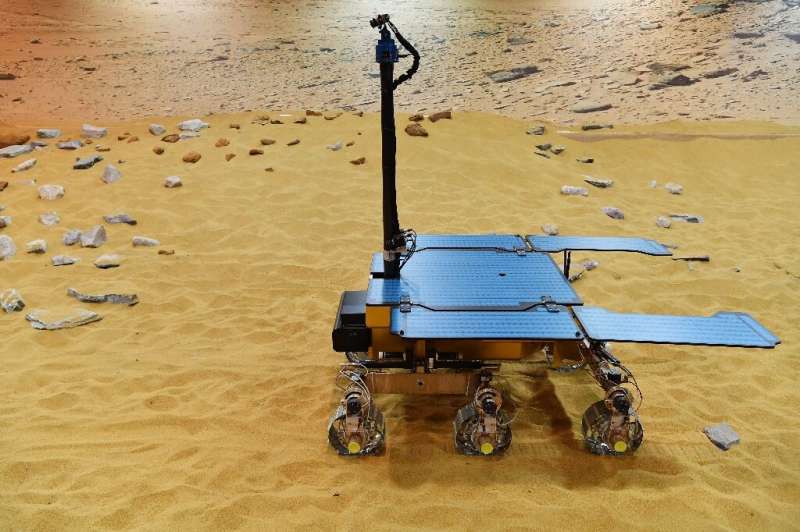
The European Space Agency has officially terminated cooperation with Russia on a mission to put a rover on Mars, with Russia's space chief furiously responding by banning cosmonauts on the ISS from using a Europe-made robotic arm.
The ESA had previously suspended ties on the joint ExoMars mission, which had planned to use Russian rockets to put Europe's Rosalind Franklin rover on the red planet to drill for signs of life, due to Russia's invasion of Ukraine.
ESA Director-General Josef Aschbacher tweeted on Tuesday that because the war and resulting sanctions "continue to prevail", the agency would "officially terminate" ties with Russia on ExoMars and its landing platform.
The firebrand head of Russian space agency Roscosmos Dmitry Rogozin issued an angry response.
"Has the head of the European Space Agency thought about the work of thousands of scientists and engineers in Europe and Russia which has been ended by this decision? Is he prepared to answer for sabotaging a joint Mars mission?" Rogozin said on Telegram.





